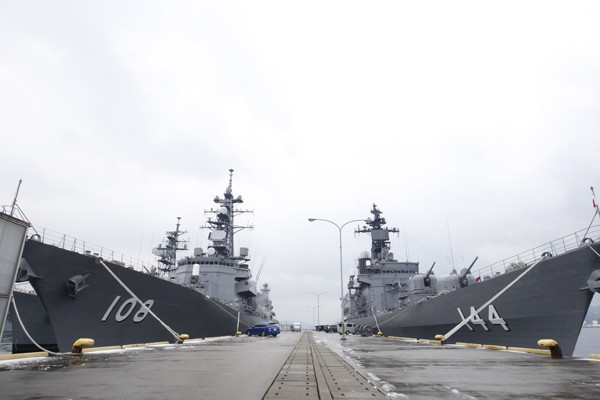Going all out to cooperate with the Japan Maritime Self Defense Force (JMSDF)!
To record “that sound” of the Harekaze, the ship featured in the series, the staff of Haifuri headed for the JMSDF Sasebo Naval Base in Nagasaki Prefecture!!

-
■The planes aren’t flying!
One day in January, when a major cold wave hit the coast of the Sea of Japan (this occurs once in 10 years), the staff of Haifuri was at Haneda Airport and at a loss. The Harekaze is Haifuri’s main location, the home of Akeno and her crew. The interior of the ship would be depicted, so certain sounds would be indispensable, such as the sound of the ship’s engine. And so the Haifuri staffers headed for the JMSDF Sasebo Naval Base to sample from a real escort ship… or that was the plan, until the cold wave grounded all planes going to Nagasaki.
They got as far as Fukuoka Airport, where they tried making it the rest of the way by train, but the schedule was in disarray. In the end, they arrived at Sasebo Station, though at 1:00 in the morning… -

They got as far as Hakata, but the train was more than an hour late. Here, the staff shivers in the cold while waiting on the platform.
-
■Just one ship
So why did the staff come all the way to Sasebo? No doubt many of you would think they should have just gone to the JMSDF base in Yokosuka, near Tokyo. The answer is they were intent on getting the “sound” of the real thing… and the destroyer that is equipped with a steam turbine engine¬¬– the same engine that the Harekaze has– is only at Sasebo! Or to be even more precise, among the over 100 current JMSDF military vessels, there is only one, the destroyer Kurama!
A gallant crew member of the destroyer Kurama and the Haifuri staff. The Kurama was commissioned in 1981 and is the second member of the Shirane-class helicopter destroyer. It strengthens the anti-submarine helicopter mother ship with three anti-sub helicopters of its own. As the flagship of destroyers, the Kurama has played a central role for many years, but is scheduled to be retired in the near future.

The Haifuri staff boards the Kurama!
-
■Steam turbine engine
A steam turbine engine, as its name suggests, uses pressurized steam to turn the turbine and generate power. In the world of Haifuri, this is the main type of engine among World War II-era combat ships. Perhaps many of you have heard of the “warship-style turbine”, Japan’s first steam turbine engine, which was developed under the leadership of the Imperial Japanese Navy Shipping Command.
The engine control room, where the steam turbine engine is controlled. Recent warships have been going digital, with gauges displayed on monitors, but the 80s-era Kurama still has analog gauges.

Mr. Konno, in charge of sound effects, records the sound of the engine control room.

This is the engine room, which houses the steam turbine engine and two propellers. There are actually two engine rooms on the ship. (The engine control room is the first one.)

An engineer puts his ear to the “stethoscope rod.” He is listening to the sound of the gears inside the turbine. He detects engine problems by the sound.

The boiler room is below the engine room (and there are two of these rooms as well). Here, the steam power is regulated and the steam is generated. If a fixed amount of steam power isn’t maintained, knocking occurs, which can apparently cause the ship to shake in a major way…

Through the small window, brilliantly burning flames can be seen in the boiler room. We’re told that the heat level is about to be checked.

There is also a household shrine in a pillar in the engine room.
-
Steam turbine engines were used for a long time even after the war, but from the 70s and 80s, gas turbine engines, which could be started up in a shorter period of time, became the norm. Even in the JMSDF, the Kurama is the last ship left equipped with a steam turbine engine.
-
■We recorded this sound, too!
On this research visit, we not only recorded the sound of the engine, but also the various “sounds” that are frequently heard on board the Kurama during an average day. Of course, that includes this sound…
The whistle known as a “side pipe” first saw use here during the days of the Imperial Japanese Navy. Now it is used for a variety of calls, signals, and commands. (It is said that the side pipe originated with the English Navy.)

This is a side pipe. The opening is adjusted by hand to change the sound. It has a characteristic high-pitched tweet.

What is a self-defense force without a bugle?! The JMSDF bugle has been handed down from the Imperial Japanese Navy, so the melody and tempo are different from that of the Japan Ground Self-Defense Force. The sound changes depending on the opening of the player’s mouth as well as their breath modulation. It apparently takes three years of practice to be able to play well.
-


The flag semaphore for “SORRY.” This is where we got the semaphore used in the first episode, when the Harekaze signals an apology to the instructor ship for being late to the rendezvous.


